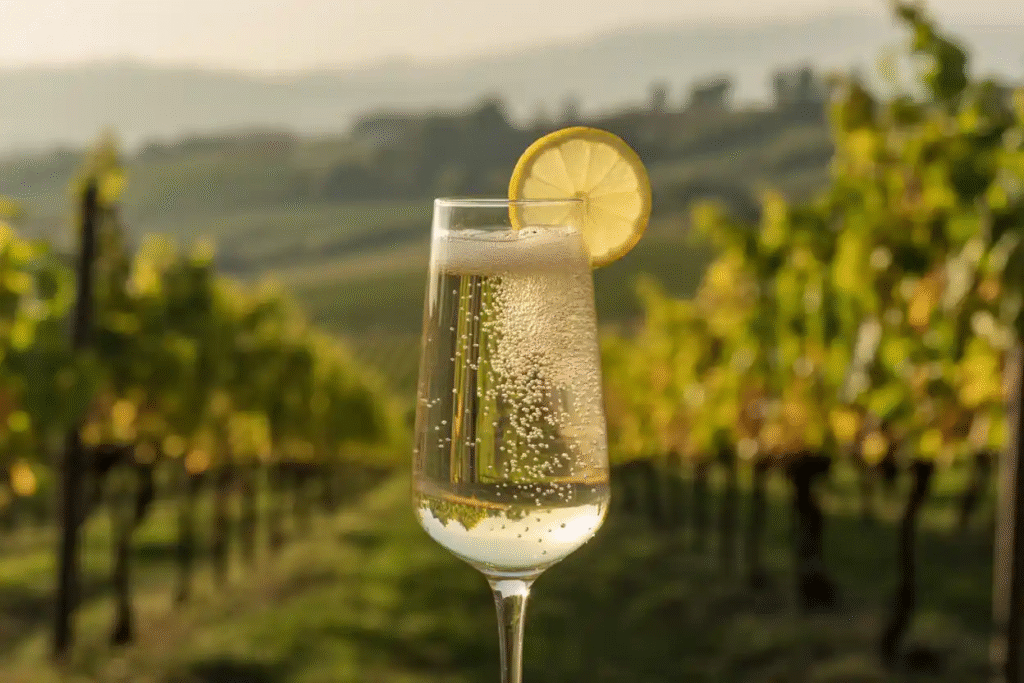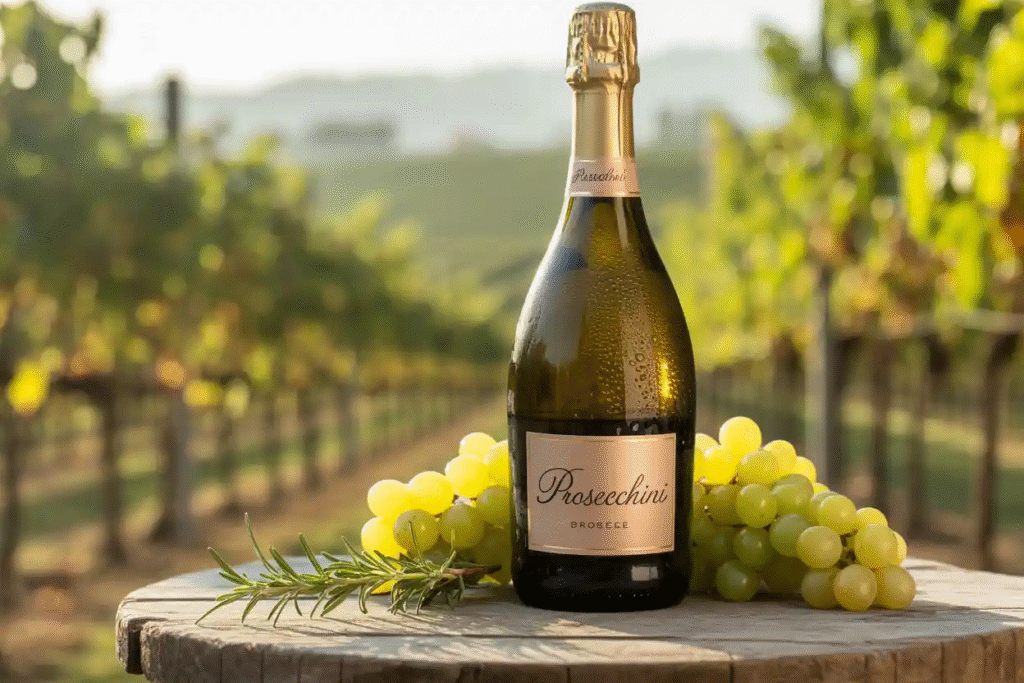
Are you searching for information about “Prosecchini”? You’ve come to the right place! While Prosecchini isn’t an official wine classification, you are likely looking for Prosecco—Italy’s beloved, light, and wonderfully bubbly sparkling wine. This article is your ultimate guide, covering everything from its protected Italian origins and unique production method to the best food pairings and how to serve it like a professional.
By the end of this comprehensive guide, you’ll possess the expertise to confidently choose, serve, and enjoy this incredibly popular sparkling wine, ensuring you always know how to properly pop a cork for any celebration. Prosecco is more than just bubbles; it’s a taste of the Italian good life, the Dolce Vita.
The Essential Facts: What Exactly is Prosecco?
Prosecco is a Denominazione di Origine Controllata (DOC) or DOCG Italian white sparkling wine. This protected status means that for a wine to legally carry the name Prosecco, it must adhere to strict rules regarding its geography and production. This is a crucial detail that establishes its quality and authenticity.
The wine is renowned for its signature fresh, aromatic, and fruity profile, making it a favorite globally for everything from brunch mimosas to elegant aperitifs. It stands apart from French Champagne due to its primary grape and its specialized fermentation process.
The Glera Grape and Protected Origins
The foundation of authentic Prosecco is the Glera grape, which must make up at least 85% of the finished wine. This high-acid, thin-skinned grape is responsible for the wine’s characteristic notes of green apple, honeydew melon, pear, and white flowers.
- Region: Prosecco can only be produced in a designated area spanning nine provinces across the Veneto and Friuli Venezia Giulia regions of Northeast Italy.
- The Best: The very best examples, labeled as Prosecco Superiore DOCG, come specifically from the steep, prestigious hills between the towns of Conegliano and Valdobbiadene. This is where the highest quality, most terroir-driven examples are found.

How is Prosecco Made? The Charmat Method
The production method is the most significant factor that defines Prosecco’s light, fruit-forward style and distinguishes it from Champagne. Unlike Champagne, which uses the traditional method (secondary fermentation in the bottle), Prosecco uses the efficient and flavor-preserving Charmat Method (also known as the Tank Method).
The Charmat Method ensures the wine’s characteristic aromatic freshness is maintained, delivering a crisper, fruitier profile rather than the bready, yeasty notes often found in Champagne.
The Key Steps of Charmat Method Production:
- First Fermentation: The base wine is created from the freshly harvested Glera grapes, fermented into a still, dry wine.
- Second Fermentation (The Bubbles): The base wine is then transferred into large, pressurized stainless steel tanks (called autoclaves). Here, a mixture of sugar and yeast is added, triggering a secondary fermentation.
- Trapping the Fizz: Because the tank is sealed, the carbon dioxide (CO2) produced by the yeast is trapped inside and naturally dissolves into the wine, creating the bubbles, known as perlage.
- Maturation and Bottling: This process is faster than the traditional method, usually taking anywhere from 30 days up to six months. This rapid process preserves the Glera grape’s fresh fruit and floral aromas, which are central to the Prosecco style.
This quicker, more scalable method is why Prosecco is generally more affordable and approachable than its French counterpart, making it the perfect everyday sparkling wine.

Understanding the Styles: From Bone Dry to Sweet
Prosecco is produced in three primary levels of effervescence (fizz) and six different levels of sweetness, which can often be confusing due to Italian labeling conventions. Knowing these terms is the key to choosing the perfect bottle for your palate.
Levels of Effervescence:
| Italian Term | English Translation | Pressure Level | Bubble Characteristics |
| Spumante | Sparkling | High pressure (≥3 bar) | Fully sparkling, long-lasting bubbles |
| Frizzante | Semi-Sparkling | Low pressure (1–2.5 bar) | Gently fizzy, less persistent bubbles |
| Tranquillo | Still | No bubbles | Very rare, non-sparkling wine |
Levels of Sweetness (Residual Sugar, RS):
The labels on Prosecco can be counter-intuitive. Always remember that “Brut” is the driest and “Dry” is actually medium-sweet.
- Brut Nature: Bone dry (0–3 g/L RS). The driest style, excellent with seafood.
- Extra Brut: Very dry (0–6 g/L RS). Crisp and clean.
- Brut: Dry (0–12 g/L RS). The most common and versatile style, often tasting fruity.
- Extra Dry: Off-dry/Slightly Sweet (12–17 g/L RS). This is actually sweeter than Brut and is the classic choice for an aperitif.
- Dry: Medium Sweet (17–32 g/L RS). Often served with mild desserts or spicier dishes.
- Demi-Sec: Sweet (32–50 g/L RS). Best paired with sweet desserts.
Expert Pairing and Serving Guide
One of the great joys of Prosecco is its exceptional versatility. Its bright acidity and light body make it a fantastic match for food that often overwhelms heavier wines. Follow these tips to maximize your enjoyment of this Italian classic.
The Best Food Pairings:
Prosecco’s high acidity and palate-cleansing bubbles make it a winner with:
- Aperitifs and Appetizers: A natural fit for its intended role in Italy. Think prosciutto, salami, lightly salted nuts, and olives.
- Spicy Asian Cuisine: The slight sweetness of an Extra Dry Prosecco balances the heat in Thai or Vietnamese dishes like Pad Thai.
- Light Cheeses: Soft, creamy cheeses such as fresh mozzarella, goat cheese, and Brie pair beautifully with its fruity notes.
- Seafood: Its crispness cuts through the richness of fried calamari, shrimp scampi, or fresh oysters.
How to Serve Like a Professional:
- Temperature: Serve Prosecco chilled—ideally between 42°F to 48°F (6∘C to 9∘C). Always keep the bottle in a bucket of ice and water for at least 30 minutes before serving.
- Glassware: Ditch the wide Champagne coupe. Experts recommend serving Prosecco in a narrow, tall, trumpet-shaped flute or, even better, a tulip-shaped glass. The tulip shape concentrates the wine’s delicate aromas at the rim, enhancing the tasting experience.
- Cocktails: Prosecco is the indispensable base for some of the world’s most famous cocktails, most notably the Venetian Bellini (Prosecco with peach purée) and, of course, the vibrant orange Aperol Spritz.

Prosecco vs. Champagne: Understanding the Difference
The most common question about any sparkling wine concerns its French cousin. While both are fantastic examples of bubbly, their core differences are what define their unique character and cost.
| Feature | Prosecco | Champagne |
| Primary Grape | Glera (≥85%) | Chardonnay, Pinot Noir, Pinot Meunier |
| Origin | Veneto & Friuli Venezia Giulia, Italy | Champagne Region, France |
| Production Method | Charmat Method (Tank fermentation) | Traditional Method (Bottle fermentation) |
| Flavor Profile | Light, fresh, fruit-driven (apple, pear, citrus) | Complex, yeasty, bready, or toasty notes |
| Atmospheric Pressure | Lower (softer, lighter bubbles) | Higher (finer, more persistent bubbles) |
| Typical Price | More affordable, excellent for everyday use | Higher, often reserved for special occasions |
Prosecco focuses on the purity of the Glera grape’s primary fruit aromas, whereas Champagne is defined by the complex, savory flavors developed from its extended aging on the yeast sediment. Neither is “better”—they are simply two distinct styles for different occasions.
Conclusion: Embrace the Italian Sparkle
If you were searching for “Prosecchini,” you were likely seeking the crisp, delightful sparkle of Prosecco—and now you have all the knowledge needed to become an expert. Its protected status, unique Charmat method, and incredible versatility make it one of the world’s most accessible and enjoyable fine wines.
The next time you’re celebrating a milestone, hosting a dinner party, or simply enjoying a weekend brunch, reach for a bottle of well-chilled Prosecco DOC or DOCG. You’ll be pouring a piece of Italian heritage, full of fresh aromas and bright, lively bubbles that always hit the mark. Salute!


